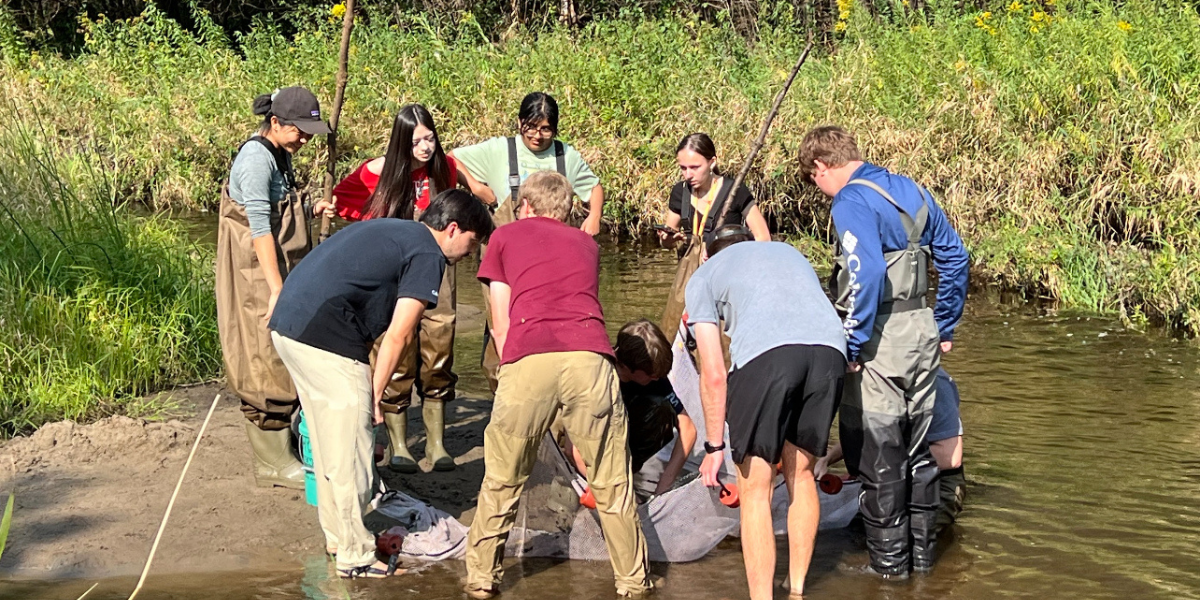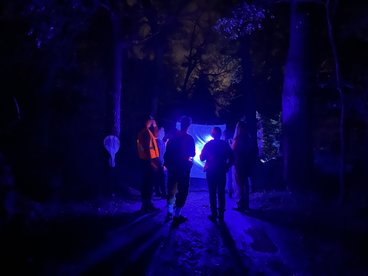
Let's talk about the Fisheries, Wildlife, and Conservation Biology Club

FWCB Club members checking a seining net for fish and aquatic animals at Nine Mile Creek Park at an outing in September
By Elena Mathern, BS ‘25, Environmental Sciences, Policy, and Management
Fisheries, Wildlife, and Conservation Biology (FWCB) is a popular major within CFANS, and a community connected to it includes the FWCB Club. We spoke with Henry Parks, the FWCB Club's current president, to discuss all the great things the club has to offer. Email FWCBClub@umn.edu or speak with a current member to get involved.
What are some goals the FWCB Club strives to achieve?
The FWCB Club strives to connect students with recreational and professional opportunities to engage with fish and wildlife and the professionals who study them. We also hope to create a space for people who share interests in these topics to build community and find a sense of belonging on campus. The club is passionate about the magic of the outdoors and the specific “flavor” of magic that comes with close encounters with wildlife and fish. We will gladly take any opportunity to provide students with that!
Are there any requirements for being in the club?
There are no club membership requirements—we are open to all majors and years in school. Everybody is welcome to all of your events, and we welcome you to come to the things that interest you and to stay home for what doesn’t. We cater to various interests but also want to respect everybody’s time as a student.
How did you get involved in FWCB club?

FWCB is a large major with students across a broad spectrum of interests and backgrounds, which can be a little daunting for somebody new to the program. I got involved because I was seeking to meet more students in my major and learn about the routes to a fish and wildlife career. Many FWCB roles outside of the major are unconventional and counterintuitive — gaining hands-on experience while learning about these opportunities and the skills necessary for them has been a fantastic highlight of my time here. All in a year, I got to hold baby bear cubs, take apart (and reconstruct) a beaver dam, handle numerous ancient Minnesota fish, cross numerous bird species off my life-bucket list, and attend a professional conference exclusively designed for wildlife professionals.
How would you describe the community this group fosters?
FWCB Club is an extraordinary space that excels in our ability to mutually nerd out about our interests in wildlife and fish. Very seldom will you have a group of people in a room together that can discuss the plumage of fall warblers, advise on fishing rigs, and figure out what sort of animal made that footprint in the mud! Though we have regular members from all across UMN, we also provide a dedicated space for FWCB majors to connect and discuss courses and opportunities.
What events or traditions does the Club participate in?
We hold many kinds of events that cover various topics, making them hard to categorize. Generally, we aim to host field events multiple times monthly to get members outside and up close with fish and wildlife. This has included visits to the Minnesota Landscape Arboretum, installation of a flow device in a beaver dam, shadowing with bird banders and bear biologists, identification workshops, and more!
Though our events change yearly, we have some favorite traditions, including visiting Hawk Ridge in Duluth, lynx tracking with the USDA Forest Service in the winter, and involving our countless collaborators across all threads of the fish and wildlife profession.
What are your favorite parts about being a member of FWCB Club?
I love to learn more about other members' different interests and admire and appreciate all the various ways you can use this major to mold your career. There are folks in the club interested in things ranging from large mammalian predator-prey ecology to the evolutionary biology of fishes to songbird migration to coral reef ecology and management. Having conversations with students and learning more about the different ways that people engage with this field of study is incredible, and finding those with unique interests is remarkable.

FWCB encompasses many different specializations; what are some ways that the club touches on those topics?
We have to be very mindful in our planning efforts to ensure our offerings are not skewed in one particular direction, which is where the effort of our area-specific officers comes in handy. Our primary goal is to host events focused on different areas of interest as often as possible to ensure our work as officers can serve as many students as possible.
Does the FWCB Club get involved with other organizations at the U of M or outside school?
A favorite thing we can do as a club is collaborate with other organizations and clubs on campus. Our favorites are those with a similar interest, including the Forestry Club, Ecology, Evolution, and Behavior Club, Marine Biology Club, and others. We also frequently collaborate with agency professionals in Minnesota Department of Natural Resources, U.S. Fish and Wildlife Service, and other private organizations.
The Club’s website features internship and job opportunities. Do you hold networking events or foster mentorship?
One of our core values is providing students with opportunities to engage with careers and network. We collaborate with the Department of Fisheries, Wildlife and Conservation Biology as often as possible to connect students with faculty and graduate students. Additionally, we maintain an internship opportunity spreadsheet that can connect students to opportunities as they come in.





